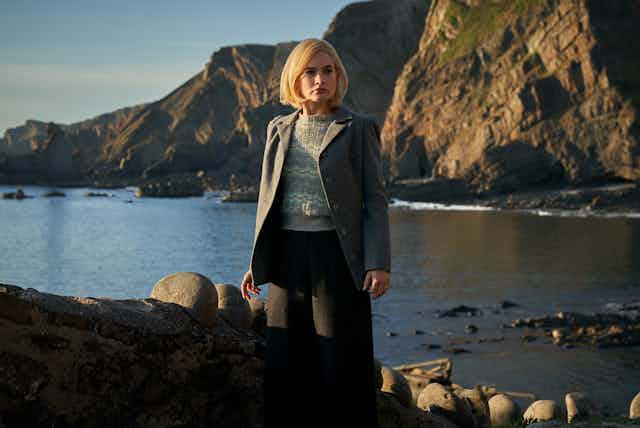Ben Wheatley’s adaptation of Daphne du Maurier’s novel Rebecca showcases the English county of Cornwall as a Gothic space of tumultuous waters, coarse moorlands, and perilous cliffs. Du Maurier’s Cornwall was a haunted place and the author was drawing upon a long tradition of seeing the Duchy as spectral and monstrous.
While Rebecca was published in 1938, Cornwall’s legends, landscape, and distinctive identity lent themselves to the gothic imagination from the end of the 18th century. As far afield as the US, Cornwall was perceived as a place of hauntings, madness, and death — a foreign, liminal threat composed of precipices and thresholds which would influence subsequent representations of the county. This could be seen in Charles Brockden Brown’s 1798 novel Wieland. An early example of American gothic, it follows a man who visits Cornwall with his family, where he loses his mind and jumps from the cliffs.
By the 19th century, these Gothic representations of Cornwall see a sudden boom as the county became increasingly prevalent in the wider British imagination due to a series of rapid cultural changes. These include being one of the last counties to be connected to the national railway, the collapse of the mining industry, the birth of tourism, and a period of mass migration out of the county.
All such changes spoke to more generalised Victorian anxieties of globalisation, modernity and the industrial revolution, which caused concerns about changing economies, collapsing industries, and social (and geographical) mobility. People were also becoming more aware of Cornwall due to an increase in travel narratives, travel guides, folklore collections and stories featuring the county, as part of the rise of a print culture. Increased ease of access to the county through travel also increased the county’s notoriety and what people found struck them as strange.
The architect John D. Sedding in 1887 stated that:
On whatever side you like to take it, the historic, the pre-historic, the natural, architectural, geological, ornithological, or on the side of its folklore, Christian or heathen — the place teems with subject matter that is as curious as it is interesting. Cornwall is the nursery ground of the saints; the fabled land of Lyonesse; the home of the giants; the haunt of fairies, pixies, mermaids, demons, and spectres. To speak of its natural aspects, its wild seaboard, and frequent air of savagery, one is almost bound to use terms of fancy.
These features provided ample fuel for gothic authors of the time.
An ancient place
Bram Stoker, the author of Dracula, set The Jewel of Seven Stars in Cornwall in 1903. The story features the mummy of an Egyptian queen that requires a suitably ancient, foreign land in which to be resurrected. Explaining why Cornwall is the perfect place, the novel’s Egyptologist, Abel Trelawny, says:
In a hundred different ways [Cornwall] fulfils the conditions which I am led to believe are primary with regard to success. Here, we are, and shall be, as isolated as Queen Tera herself would have been in her rocky tomb in the Valley of the Sorcerer, and still in a rocky cavern.
Beneath Cornwall lies labyrinths of mining chambers, which could be seen as not too far removed from graves or tombs. The county is also isolated at the “Land’s End”, and associated with magic and mystery, partially through Merlin and King Arthur.
In Thomas Hardy’s early novel A Pair of Blue Eyes (1873), two suitors fight for a Cornish maiden, travelling from London on the new rail network to Cornwall. While the two vie for her hand, neither is aware that she is also on board; however, she is travelling as cargo rather than as a passenger as she lies in a coffin journeying home for the last time. The incoming Londoners arguing over an already dead Cornish woman speaks to anxieties over the coming of the rail and how an influx of “outsiders” might change Cornwall as expressed by the writer William Connor Sydney in 1897:
Railways, and the gradual assimilation of its people more and more into ordinary English society will have the effect, it is greatly to be feared, of banishing its huge array of witches and hobgoblins, giants and dwarfs, grim spectres, and haunted corridors to the limbo of things that had been.

Arthur Conan Doyle even sent Holmes and Watson to Cornwall for a retreat in The Adventure of the Devil’s Foot (1910) only for them, unsurprisingly, to encounter “the Cornish horror – [the] strangest case I have handled”.
Ghosts and gold
Mines and subterranean spaces, in particular, inspired several gothic tales. On such tale is Joseph F. Pearce’s The Man Who Coined His Blood Into Gold (1893) where a poverty-stricken miner is told by an underground goblin that he can transform each drop of his blood into gold coin with magic. The miner is later found, dead amongst his glittering horde. The tale appeals to 19th-century anxieties surrounding the collapse of the mining industry and the ravages of industrial capitalism.
Cornwall’s landscape is unique for both its world-famous mine networks and rugged coastlines, notorious for shipwrecks. Margery Williams, most famous for the children’s story The Velveteen Rabbit (1922) set The Last Mitchell (1905) in Cornwall, where a “living” ghost, having perished in a wreck, haunts his ancestral home, only to finally vanish once his body is returned to his home.
Edgar Allan Poe, the poster child of the gothic, even ventured as far as Cornwall, “one of the wildest and least frequented portions of fair England,” in his short story Ligeia (1838), where a man is visited there by the spectre of his lost sweetheart.
Cornwall’s dislocation from the mainland, its reputation as both “English and not-English’”, its tempestuous and radical history, and its wealth of folklore and legends, all lend themselves to a Gothic literary tradition that stretches over 222 years. With Wheatley’s incarnation of the mysterious county, it’s certain that this place of ghosts and magic still captures our imaginations today.

